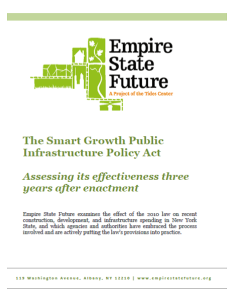New York State will be changed considerably for the better if the Smart Growth Public Infrastructure Policy Act is fully implemented in a reasonable time. The potential effects are far-reaching in construction, housing, and overall economic development.
The law is designed to shape an enormous amount of capital spending, whether by the state or through its approvals of private sector projects. Spending billions of dollars the right way will lead to a more economically and environmentally sustainable and equitable New York. In 2010 Empire State Future joined others who pushed strongly for passage of the bill, and we’ve been monitoring government’s fulfillment of this important act.
There is certainly a learning curve associated with implementing many new laws, and better focus on the Smart Growth Law will prove most beneficial as the law’s requirements become more familiar to state agencies and authorities and municipalities.
The more the Smart Growth Law is used by agencies and authorities, the word that it’s here to stay will get out to the involved constituencies who will then understand that the goal is construction and development proposals must reflect Smart Growth standards at their inception.
What Empire State Future has been able to determine with its analysis, published in reports issued in 2012 and 2014, is that the law is a helpful tool, albeit sometimes an unfamiliar one. For those agencies that have been employing it, a layer of transparency for infrastructure funding emerges that helps protect from costly or wasteful spending. The law’s requirement for Smart Growth Impact Statements can also be viewed as a template of sorts, allowing an agency, authority, or municipality to exclude spending on noncompliant projects — and also allowing decision makers and stakeholders to have a method to determine what noncompliant means.
We applaud the progress evident since our initial report in 2012, and hope that the areas of noncompliance receive the proper focus and intervention required. We urge continued progress through increased outreach education and awareness at all levels of government.
 With its 2014 report, Empire State Future has sought to reinforce a number of important points regarding the implementation of the Smart Growth Law and how it must be enforced fully and equally.
With its 2014 report, Empire State Future has sought to reinforce a number of important points regarding the implementation of the Smart Growth Law and how it must be enforced fully and equally.
We continue to emphasize the proposition that the Smart Growth Law is critical to the effective allocation of infrastructure spending, and to providing the essential transparency of public expenditures in the challenging economic climate of today. Only by using the Law as a benchmark for smart spending will its original goals and intent be realized.
The need for law was recognized by both Republicans and Democrats in the Legislature who understood that only smart and optimized expenditures of the state’s limited infrastructure resources would allow New York and its localities to prosper. Meeting the challenges of keeping our water, sewer, bridge, road, transit, and other critical systems in a state of good repair while providing funding for needed new engines of growth is a major challenge that the law is intended to address. It law was passed overwhelmingly, with all but five of New York’s 210 legislators voting in favor, with supporters thereby including the state’s most conservative and rural members of the Senate and Assembly.
Under Governor Patterson who signed it and Governor Cuomo who has continued its execution, the law has migrated into the actions and decisions of hundreds of state agencies, public authorities and corporations, and municipalities. The law’s intent has concurrently made substantial inroads into the thinking and planning of the numerous consultants, planners, developers and engineers who conceive of and help to direct capital projects across New York. We have found that with a few exceptions, this implementation is moving forward generally well.
Empire State Future’s reports showed that many state agencies had begun to take the required steps, including forming stakeholder committees, conducting Smart Growth reviews, and issuing Smart Growth impact statements. We reported on the impact of the law at the project level including some easy successes, many hard choices, and some ongoing flaws.
One clear omission that has been identified in the law is the lack of inclusion of the tax-credit based activities of state and local economic development agencies, which should be integrated into the program. Some economic development activities in New York are ineffective, non-transparent, not aligned or coordinated with overall infrastructure spending, and subject to inappropriate giveaways and subsidies. While the Regional Economic Development Council process has address much of this problem, amending the law would make it easier for the Empire State Development Corporation and the Industrial Development Agency’s to make investments more in line with Smart Growth principles.
As we move into the third year meeting the requirements of the Law, Empire State Future recommends continuation of the progress made to date and steps that will improve on the Law’s effectiveness by:
- Including coverage of all public agencies and authorities in the requirements of the Smart Growth Infrastructure Policy Act
- Specifically, the SUNY Construction Fund and other similar agencies, as well as the Regional Economic Development Councils, should be subject to the Smart Growth Law
- Similarly, the actions of tax credit-granting organizations such as local Economic Development Authorities should be brought under the requirements of the Law
- Incorporate the financing activities of “pass through agencies” such as the New York State Dormitory Authority and similar organizations that provide funding for state supported construction (these organizations are critical to actually building hundreds of millions in construction annually in New York, but they currently escape notice because of their position that they do not decide the fate of projects, and only supply financing).



